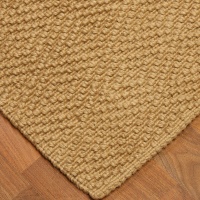When you choose a jute rug, you have an attractive floor covering and you also have the benefit of flooring that will last. Biodegradable jute carpet is an excellent choice for the contemporary shopper who’s environmentally aware.
What Is Jute?
Jute is the most cultivated plant fiber in the world after cotton however because nearly 85 percent of jute cultivation is concentrated in India’s Ganges delta region, this natural fiber is not very well known to Westerners by name. Westerners are very familiar with products made from jute fiber however, particularly burlap, sack cloth, twine and rope.
What Is a Jute Rug?
Traditionally, the world’s most gifted Oriental carpet makers used jute backing for their masterpieces of interwoven wool, cotton and silk yarns. More recently, jute has come into its own as a primary material for rugs, carpet and other floor coverings.
Jute fiber can be spun into a strong and durable thread. Jute fibers tend to have a rough texture, but when jute cords are separated out into finer threads, those threads feel like silk. Finer jute threads are what are used to create jute carpet and jute rugs.
In its natural state, jute fiber has an attractive golden sheen that has led to jute’s nickname as the Golden Fiber. Jute also takes dye very well, and is often blended with other natural and synthetic fibers to create textured patterns in carpet.
Jute carpet is typically produced using broadloom methods or by braiding. Jute will adhere to your floor quite well so it doesn’t need a latex backing and often a cotton or a wool border will be added to a jute area rug for aesthetic reasons.
Like floor coverings made from other natural plant fibers, a natural jute rug is a good option in environments that do not have or retain a lot of moisture. If jute becomes wet repeatedly, the fibers can lose their strength and begin to break and they may also become a medium for mildew and bacteria. Jute can also become brittle and yellow if it’s exposed to direct sunlight for prolonged periods of time.
What Are the Benefits of Buying a Jute Rug?
Jute area rugs are beautifully textured pieces that are perfect for accenting specific areas of the rooms they’re in. Jute is probably the least expensive natural material available on the market today, so jute floor coverings tend to be relatively inexpensive. Jute fibers are among the strongest of all organic fibers, so a jute rug will last for a long time and stand up to hard use. Jute floor covering also requires very little maintenance; routine vacuuming will remove most dirt and dust. Jute is also a poor conductor of electricity, so static electricity won’t build up in a jute rug. Unlike seagrass and sisal, jute is not a particularly slick material so a jute runner on your staircase is a great option.
Best of all, jute is an ecologically friendly fiber. It doesn’t require pesticides or chemical fertilizers to grow, and it’s completely biodegradable.
Jute floor coverings are attractive, long lasting and represent some of the very best values consumers will find in natural floor coverings today.


